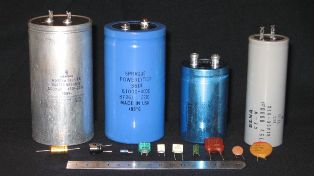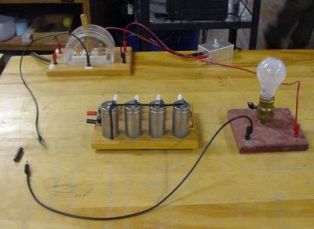Electric field, electrostatic induction, capacitance and capacitors
Electric field concept
Electric field forces are known to act in the space around electric charges. Numerous experiments on charged bodies fully confirm this. The space around any charged body is an electric field in which electric forces act.
The direction of the field forces are called electric field lines. Therefore, it is generally accepted that an electric field is a collection of lines of force.
The field lines have certain properties:
-
lines of force always leave a positively charged body and enter a negatively charged body;
-
they exit in all directions perpendicular to the surface of the charged body and enter it perpendicularly;
-
the lines of force of two equally charged bodies seem to repel each other, and oppositely charged bodies attract.
The electric field lines of force are always open as they break at the surface of charged bodies.Electrically charged bodies interact: oppositely charged attract and similarly repel.

Electrically charged bodies (particles) with charges q1 and q2 interact with each other with a force F, which is a vector quantity and is measured in newtons (N). Bodies with opposite charges attract each other and with similar charges repel each other.
The force of attraction or repulsion depends on the magnitude of the charges on the bodies and on the distance between them.
Charged bodies are called point if their linear dimensions are small compared to the distance r between the bodies. The magnitude of their interaction force F depends on the magnitude of the charges q1 and q2, the distance r between them and the environment in which the electric charges are located.
If there is no air in the space between the bodies, but some other dielectric, that is, a non-conductor of electricity, then the force of interaction between the bodies will decrease.
The value characterizing the properties of a dielectric and showing how many times the force of interaction between charges will increase if a given dielectric is replaced by air is called the relative permittivity of a given dielectric.
The dielectric constant is equal to: for air and gases — 1; for ebonite — 2 — 4; for mica 5 — 8; for oil 2 — 5; for paper 2 — 2.5; for paraffin — 2 — 2.6.
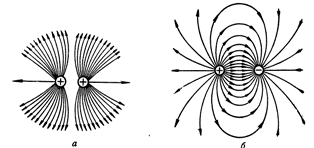
The electrostatic field of two charged bodies: a — tala are charged with the same name, b — bodies are charged differently
Electrostatic induction
If a conducting body A with a spherical shape, isolated from surrounding objects, is given a negative electric charge, that is, to create an excess of electrons in it, then this charge will be evenly distributed over the surface of the body.This is because the electrons, repelling each other, tend to come to the surface of the body.
We place an uncharged body B, also isolated from surrounding objects, in the field of body A. Then electric charges will appear on the surface of body B, and on the side facing body A, a charge opposite to the charge of body A (positive ), and on the other side - a charge with the same name as the charge of the body A (negative). The electric charges thus distributed remain on the surface of body B while it is in the field of body A. If body B is removed from the field or body A is removed, then the electric charge on the surface of body B is neutralized. This method of electrification at a distance is called electrostatic induction or electrification by influence.
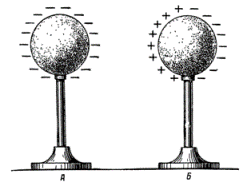
The phenomenon of electrostatic induction
It is obvious that such an electrified state of the body is forced and maintained exclusively by the action of the forces of the electric field created by body A.
If we do the same when body A is positively charged, then the free electrons from a person's hand will rush to body B, neutralize its positive charge, and body B will be negatively charged.
The higher the degree of electrification of body A, i.e. the greater its potential, the greater potential can be electrified by means of electrostatic induction body B.
Thus we came to the conclusion that the phenomenon of electrostatic induction makes it possible under certain conditions to accumulate electricity on the surface of conductive bodies.
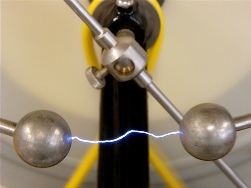
Any body can be charged to a certain limit, that is, to a certain potential; an increase in potential beyond the limit causes the body to be ejected into the surrounding atmosphere. Different bodies need different amounts of electricity to bring them to the same potential. In other words, different bodies contain different amounts of electricity, that is, they have different electrical capacities (or simply capacities).
Electrical capacity is the ability of a body to contain a certain amount of electricity while increasing its potential to a certain value. The larger the surface area of the body, the more electric charge that body can hold.
If the body has the shape of a ball, then its capacity is directly proportional to the radius of the ball. Capacitance is measured in farads.
A farada is the capacity of such a body which, after receiving a charge of electricity in a pendant, increases its potential by one volt... 1 farad = 1,000,000 microfarads.
Electrical capacity, that is, the property of conductive bodies to accumulate electric charge in themselves, is widely used in electrical engineering. The device is based on this property electrical capacitors.
Capacitance of the capacitor
A capacitor consists of two metal plates (plates), isolated from each other with an air layer or another dielectric (mica, paper, etc.).
If one of the plates is given a positive charge and the other is negative, that is, charge them oppositely, then the charges of the plates, mutually attracting, will be held on the plates. This allows much more electricity to be concentrated on the plates than if they were charged at a distance from each other.
Therefore, a capacitor can serve as a device that stores a significant amount of electricity in its plates. In other words, a capacitor is a storage of electrical energy.
The capacitance of the capacitor is equal to:
C = eS / 4pl
where C is the capacitance; e is the dielectric constant of the dielectric; S — area of one plate in cm2, NS — constant number (pi) equal to 3.14; l — distance between plates in cm.
From this formula, it can be seen that as the area of the plates increases, the capacity of the capacitor increases, and as the distance between them increases, it decreases.
Let's explain this dependency. The larger the area of the plates, the more electricity they can absorb and therefore the capacity of the capacitor will be greater.
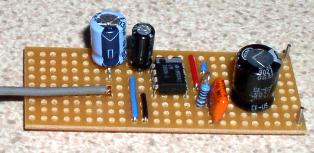
As the distance between the plates decreases, the mutual influence (induction) between their charges increases, which makes it possible to concentrate more electricity on the plates and, therefore, to increase the capacity of the capacitor.
Thus, if we want to get a large capacitor, we need to take plates with a large area and insulate them with a thin dielectric layer.
The formula also shows that as the dielectric constant of the dielectric increases, the capacitance of the capacitor increases.
Therefore, capacitors with the same geometric dimensions but containing different dielectrics have different capacitances.
If, for example, we take a capacitor with an air dielectric whose dielectric constant is equal to unity, and put mica with a dielectric constant of 5 between its plates, then the capacitance of the capacitor will increase by 5 times.
Therefore, materials such as mica, paper impregnated with paraffin, etc., whose dielectric constant is much higher than that of air, are used as dielectrics to obtain a large capacity.
Accordingly, the following types of capacitors are distinguished: air, solid dielectric and liquid dielectric.
Charging and discharging the capacitor. Bias current
Let us include a capacitor of constant capacitance in the circuit. By placing the switch on contact a, the capacitor will be included in the battery circuit. The needle of the milliammeter at the moment when the capacitor is connected to the circuit will deviate and then become zero.
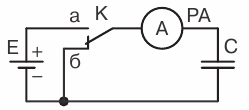
DC capacitor
Therefore, an electric current passed through the circuit in a certain direction. If the switch is now placed on contact b (ie, close the plates), then the milliammeter needle will deflect in the other direction and return to zero. Therefore, a current also passed through the circuit, but in a different direction. Let's analyze this phenomenon.
When the capacitor was connected to the battery, it was charged, that is, its plates received one positive and the other negative charge. Billing continues until potential difference between the capacitor plates is not equal to the battery voltage. A milliammeter connected in series in the circuit indicates the charging current of the capacitor, which stops immediately after the capacitor is charged.
When the capacitor was disconnected from the battery, it remained charged, and the potential difference between its plates was equal to the battery voltage.
However, as soon as the capacitor was closed, it began to discharge and the discharge current passed through the circuit, but already in the direction opposite to the charge current. This continues until the potential difference between the plates disappears, that is, until the capacitor discharges.
Therefore, if the capacitor is included in the DC circuit, the current will flow in the circuit only at the time of charging the capacitor, and in the future there will be no current in the circuit, because the circuit will be broken by the dielectric of the capacitor.
That is why they say that «A capacitor does not pass direct current».
The amount of electricity (Q) that can be concentrated on the plates of the capacitor, its capacity (C) and the value of the voltage supplied to the capacitor (U) are related by the following relationship: Q = CU.
This formula shows that the larger the capacity of the capacitor, the more electricity can be concentrated on it without significantly increasing the voltage on its plates.
Increasing the DC capacitance voltage also increases the amount of electricity stored by the capacitor. However, if a large voltage is applied to the plates of the capacitor, then the capacitor can be "broken", that is, under the action of this voltage, the dielectric will collapse in some place and let the current pass through it. In this case, the capacitor will cease to function. To avoid damage to the capacitors, they indicate the value of the permissible operating voltage.
Phenomenon of dielectric polarization
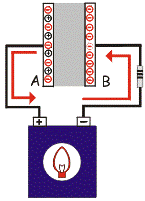 Let us now analyze what happens in a dielectric when a capacitor is charged and discharged and why the value of the capacitance depends on the dielectric constant?
Let us now analyze what happens in a dielectric when a capacitor is charged and discharged and why the value of the capacitance depends on the dielectric constant?
The answer to this question gives us the electronic theory of the structure of matter.
In a dielectric, as in any insulator, there are no free electrons. In the atoms of the dielectric, the electrons are tightly bound to the core, therefore the voltage applied to the plates of the capacitor does not cause a directional movement of electrons in its dielectric, i.e. electric current, as in the case of wires.
However, under the action of the electric field forces created by the charged plates, the electrons revolving around the atomic nucleus are displaced towards the positively charged capacitor plate. At the same time, the atom is stretched in the direction of the field lines. This state of dielectric atoms is called polarized, and the phenomenon itself is called dielectric polarization.
When the capacitor is discharged, the polarized state of the dielectric is broken, that is, the displacement of the electrons relative to the nucleus caused by the polarization disappears and the atoms return to their usual unpolarized state. It was found that the presence of dielectric weakens the field between the plates of the capacitor.
Different dielectrics under the action of the same electric field polarize to different degrees. The more easily the dielectric is polarized, the more it weakens the field. Polarization of air, for example, results in less field weakening than polarization of any other dielectric.
But the weakening of the field between the plates of the capacitor allows you to concentrate on them a greater amount of electricity Q at the same voltage U, which in turn leads to an increase in the capacity of the capacitor, since C = Q / U .
So we came to the conclusion — the greater the dielectric constant of the dielectric, the greater the capacity of the capacitor that contains this dielectric in its composition.
The displacement of electrons in the atoms of the dielectric, which occurs, as we have already said, under the action of the forces of the electric field, is formed in the dielectric, at the first moment of the action of the field, an electric current . Called a deflection current... It is so named because unlike the conduction current in metallic wires, the displacement current is generated only by the displacement of electrons moving in their atoms.
The presence of this bias current causes the capacitor connected to the AC source to become its conductor.
See also on this topic: Electric and Magnetic Field: What are the Differences?
The main characteristics of the electric field and the main electrical characteristics of the medium (basic terms and definitions)
Electric field strength
A vector quantity characterizing the force action of an electric field on electrically charged bodies and particles, equal to the limit of the ratio of the force with which the electric field acts on a stationary point-charged body introduced at the considered point of the field to the charge of this body when this charge tends to zero and whose direction is assumed to coincide with the direction of the force acting on a positively charged point body.
An electric field line
A line at any point whose tangent to it coincides with the direction of the electric field strength vector.
Electric polarization
The state of matter characterized by the fact that the electric moment of a given volume of that substance has a value other than zero.
Electrical conductivity
The property of a substance to conduct, under the influence of an electric field that does not change in time, an electric current that does not change in time.
Dielectric
A substance whose main electrical property is the ability to polarize in an electric field and in which the long-term existence of an electrostatic field is possible.
A conductive substance
A substance whose main electrical property is electrical conductivity.
Director
Conductive body.
Semiconductor substance (semiconductor)
A substance whose electrical conductivity is intermediate between a conductive substance and a dielectric and whose distinguishing properties are: a pronounced dependence of electrical conductivity on temperature; change in electrical conductivity when exposed to an electric field, light and other external factors; significant dependence of its electrical conductivity on the amount and nature of the introduced impurities, which makes it possible to amplify and correct the electric current, as well as to convert some types of energy into electricity.
Polarization (polarization intensity)
A vector quantity characterizing the degree of electric polarization of the dielectric, equal to the limit of the ratio of the electric moment of a certain volume of the dielectric to this volume when the latter tends to zero.
Electric constant
A scalar quantity characterizing the electric field in a cavity, equal to the ratio of the total electric charge contained in a certain closed surface to the flow of the electric field strength vector through this surface in the void.
Absolute dielectric susceptibility
A scalar quantity characterizing the property of a dielectric to be polarized in an electric mass, equal to the ratio of the magnitude of the polarization to the magnitude of the electric field strength.
Dielectric sensitivity
The ratio of the absolute dielectric susceptibility at the considered point of the dielectric to the electrical constant.
Electric displacement
A vector quantity equal to the geometric sum of the electric field strength at the point under consideration multiplied by the electric constant and the polarization at the same point.
Absolute dielectric constant
A scalar quantity characterizing the electrical properties of a dielectric and equal to the ratio of the magnitude of the electrical displacement to the magnitude of the electric field voltage.
The dielectric constant
The ratio of the absolute dielectric constant at the considered point of the dielectric to the electrical constant.
Displacement power line
A line at every point of which the tangent to it coincides with the direction of the electric displacement vector.
Electrostatic induction
The phenomenon of induction of electric charges on a conductive body under the influence of an external electrostatic field.
Stationary electric field
The electric field of electric currents that do not change in time, provided that the current-carrying conductors are stationary.
Potential electric field
An electric field in which the rotor of the electric field strength vector is everywhere equal to zero.
Eddy electric field
An electric field in which the rotor of the intensity vector is not always equal to zero.
The difference in electric potentials at two points
A scalar quantity characterizing a potential electric field, equal to the limit of the ratio of the work of the forces of this field, when a positively charged point body is transferred from one given point of the field to another, to the charge of this body, when the charge of the body tends to zero (otherwise: equal to the line integral of the electric field strength from one given point to another).
Electric potential at a given point
The difference between the electric potentials of a given point and another, specified but arbitrarily chosen point.
Electrical capacitance of a single conductor
A scalar quantity characterizing the ability of a conductor to accumulate electric charge, equal to the ratio of the conductor's charge to its potential, assuming that all other conductors are infinitely distant and that the potential of the infinitely distant point is assumed to be zero.
Electrical capacitance between two single conductors
A scalar value equal to the absolute value of the ratio of the electric charge on one conductor to the difference in electric potentials of two conductors, provided that these conductors have the same magnitude but opposite in sign and that all other conductors are infinitely distant.
Condenser
A system of two conductors (plates) separated by a dielectric designed to use the capacitance between the two conductors.
Capacitance of the capacitor
The absolute value of the ratio of the electric charge on one of the capacitor plates to the potential difference between them, provided that the plates have charges of the same magnitude and opposite in sign.
Capacitance between two conductors in a wire system (partial capacitance)
The absolute value of the ratio of the electric charge of one of the conductors included in the system of conductors to the potential difference between it and another conductor, if all conductors, except for the latter, have the same potential; if the ground is included in the considered system of wires, then its potential is taken as zero.
Third party electric field
The field caused by thermal processes, chemical reactions, contact phenomena, mechanical forces and other non-electromagnetic (in macroscopic examination) processes; characterized by a strong effect on charged particles and bodies located in the area where this field exists.
Induced electric field
An electric field induced by the time-varying magnetic field.
Electromotive force E. d. S.
A scalar quantity that characterizes the ability of an external and induced electric field to induce an electric current equal to the linear integral of the strength of the external and induced electric fields between two points along the considered path or along the considered closed circuit.
Voltage
A scalar quantity equal to the linear integral of the strength of the resulting electric field (electrostatic, stationary, external, inductive) between two points along the considered path.

